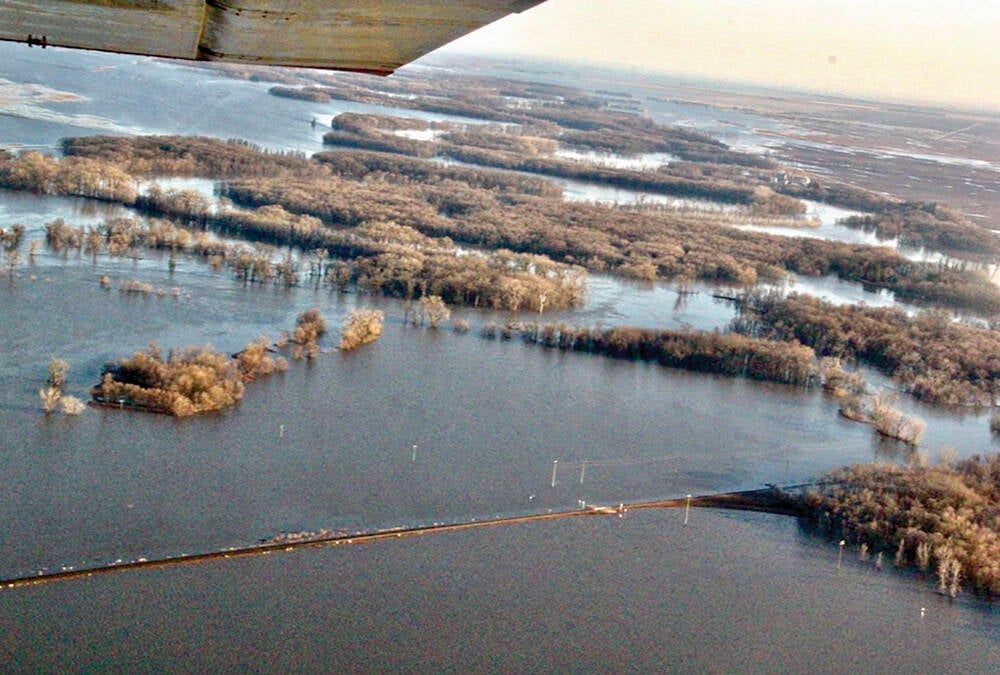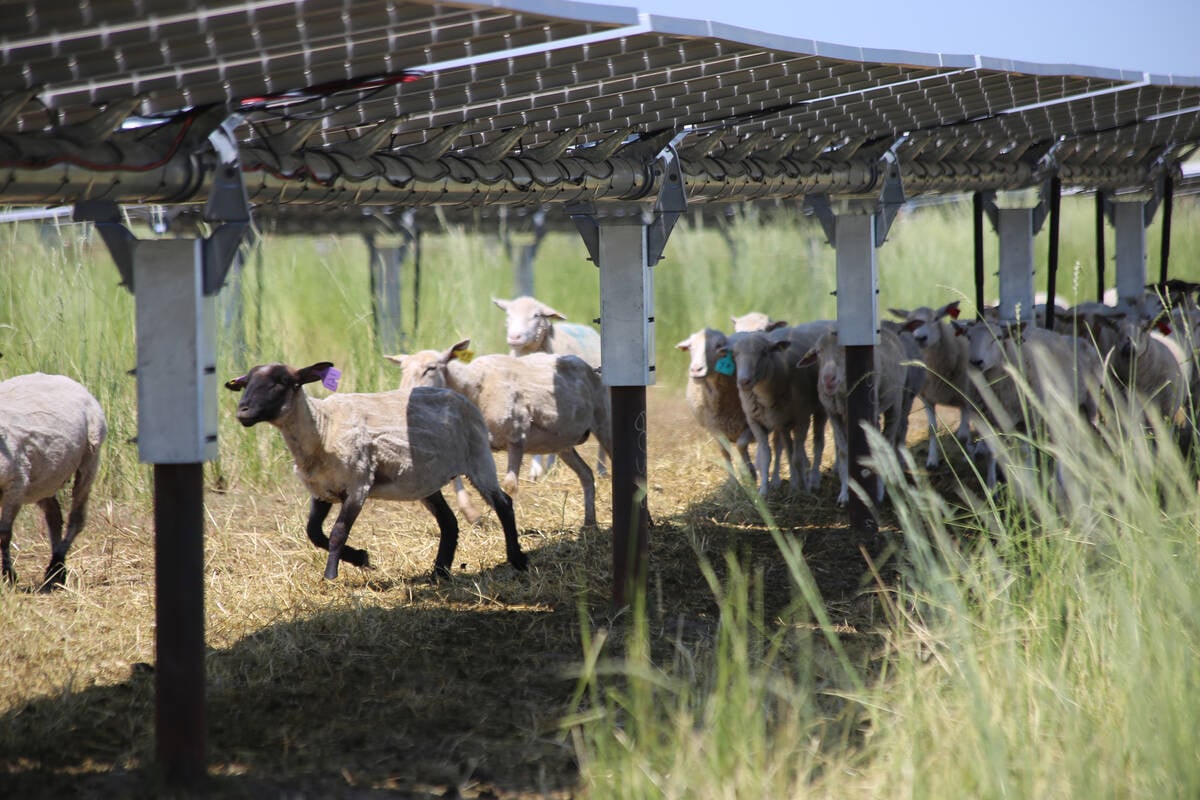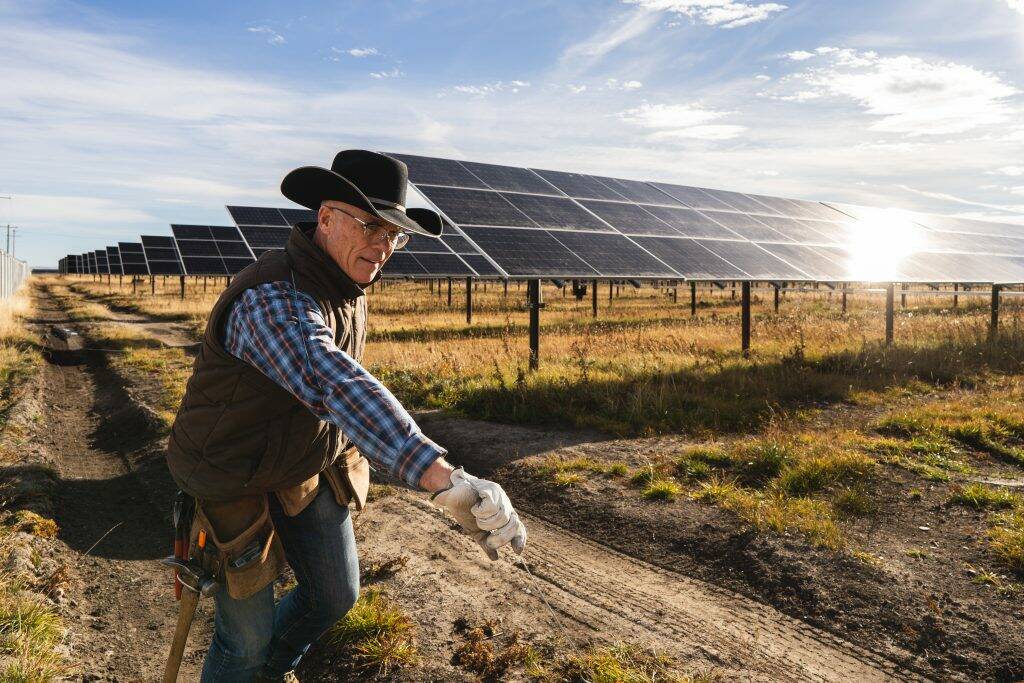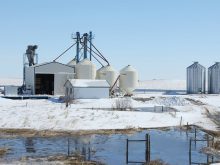Glacier FarmMedia – Canadian farmers, rural municipalities and provincial governments should welcome any opportunity to get involved in large-scale solar power installations, say farmers, consultants and industry organizations that are involved in a little-known, on-farm diversification system called agrivoltaics.
With increasing interest in renewable energy and as vast solar arrays are installed, farmers are paid considerable lease money for the use of their land, municipalities get a much enhanced tax base, and as livestock and crops are produced under what can be hundreds and sometimes thousands of acres of solar panels, it provides another revenue stream for the farm. These solar farms can produce renewable energy that can help power aspects of the provincial economy such as the relatively new industry of AI data centres. With permanent forage production, the operations helps to sequester carbon as well — many wins on the agrivoltaics score sheet.
Diversification opportunity
Read Also

Rural Manitoba resources slim on natural disaster planning
A study from Brandon University’s Rural Development Institute has found that many rural and small municipalities don’t have the staff or resources to make formal climate plans against natural disaster.
“I believe that agrivoltaics is a diversification opportunity that could be the saviour of many family farms in Canada,” says Patrick Gossage, president and board chair of Agrivoltaics Canada. That is an organization that represents all players involved in a relatively new niche area of farming.
What is agrivoltaics? Agri refers to agriculture, and voltaics (pronounced as vol-tay-icks) refers to producing energy. It is the system of producing crops and livestock under an array of solar panels.
Producing power from solar panels first appeared in Canada on a limited basis during the energy crisis of the 1970s. Fast forward a few decades, and as the cost of solar photovoltaic (PV) systems for electricity generation declined and interest in renewable energy increased, over the past 10 to 15 years there has been greater interest in producing power through solar energy.
But as these solar projects have been proposed on sites ranging from a few hundred to a few thousand acres, there was also criticism they were often taking valuable farmland out of production.
“Solar energy is not the boogeyman,” says Gossage. “That’s the message we want to get across to all levels. Properly managed, these solar power projects can actually enhance and increase agricultural production and become diversification projects that can save family farms.”
Research backed
Gossage pointed to a research project, organized by Agrivoltaics Canada on an Ontario farm of only 150 acres (fairly typical size in Ontario) that was at risk of being sold. While the “agricultural component” of most agrivoltaics projects involves livestock or honey production, for this project the design and layout of the solar array was adjusted to create more room between the rows of solar panels. The plan is for the farm to use its existing equipment to seed and harvest soybeans and grain between the solar panel rows.
“This producer will be earning money from the lease of his land to the solar developer,” says Gossage. “They’ll also be able to produce a crop on the farm as well. The lease itself will provide four times the return per acre than most commodities, and the farmer will still be able to produce a crop.”
Gossage notes while the Ontario provincial government has ruled that solar power projects cannot be developed on prime agricultural land, that does not rule out the value of including agrivoltaics in projects to improve returns to each farm.
Ontario and Alberta major players
While most provinces have some solar power projects, Ontario and Alberta are really the major players in the solar power generation in the country. One report published in 2024 showed there were nearly 100 large commercial solar projects in Canada ranging from 150 to 3,400 acres in size. These were either operational or in development. Alberta had about 54 projects, Ontario had about 37 projects and one or two each in Saskatchewan, B.C. and Prince Edward Island. For those projects where acres were cited, a partial list covered well in excess of 200,000 acres.
In Alberta, Jason Bradley, a long-time manager of a 350-head cow-calf operation near Sundre and former farm manager at Olds College, is now CEO of a multi-partnered consulting company — Sun Cycle Farms — providing a range of services to the solar energy industry.
He is a strong proponent of regenerative agriculture and extends that philosophy to regenerative agrivoltaics.
“Alberta has a number of solar power projects producing power and several more in the development stage,” says Bradley. “With agrivoltaics there is a tremendous opportunity for farmers to be involved, diversify their operations and still keep agricultural land productive.”
Renewable energy companies will pay rent for land
He notes that renewable energy companies will pay at least $700 per acre per year just to lease the land for solar projects. If the producer is also interested in providing vegetation control under and between solar arrays that can be worth another $200 or more per acre. On top of that the farmer has opportunity to raise livestock on the solar farm project to further enhance the revenue stream.
As of 2024, Alberta mandated all solar power projects over 10 megawatts (about 60 acres) must have a “farm first” plan for projects developed on Class 1 and 2 agricultural land. That means the project must include a viable agrivoltaic component.
Sun Cycle Farms can provide a range of services. They work with companies to design the solar array installation, so it is well suited to accommodate farming activity. They will work with the company or farmers to provide and manage the agrivoltaic component itself. When possible they welcome the opportunity to operate the solar plant as well as the agrivoltaic component.
“It is critical that the power plant and agrivoltaics be in collaboration with each other,” says Bradley. “Depending on the activity, the angle of the solar panels may need to be adjusted from angled, to table top, to cathedral (upright position) to accommodate grazing livestock or field operations with equipment. It helps if we can be in control of both to be able to manage timing as needed.
Farming with agrivoltaics
“Farming with agrivoltaics requires a paradigm shift in thinking for producers. With the solar installation in place, the agriculture component has to be managed within a high-voltage, industrial power plant, in the midst of screw piles, cables and transformers. It is a different environment.”
Bradley is a strong advocate that solar power projects should be installed on prime agricultural land, providing farmers the best opportunity to optimize returns through agrivoltaics.
While sheep are commonly used to provide vegetation control, Bradley says projects can also include pigs or poultry, as well as crops such as fruit and vegetable production. He also noted a research project underway involving a solar power installation owned by the town of Cardston in southern Alberta where cattle are being grazed among the solar panels. Olds College is actively involved in researching agrivoltaic options and practices.
Eric Steeves, part of the family owned Yetwood Farms near Lomond in southern Alberta, is part of the Travers Solar Project — the largest solar power development in Canada. Part of their grain farm along with several other nearby family farms have leased a total of 3,400 acres to a development that includes more than 1.3 million solar panels.

Steeves was proactive in the early planning stages and diversified their farming operation to include sheep as the agrivoltaic component of the project. They currently pasture about 2,000 ewes on the solar power site and plan to ramp that up to 8,000 head over the next few years.
Results
“This Travers project has proven to be an excellent diversification for our farm and for several other farms involved in the project,” says Steeves. He says those dryland acres included in the solar project are now earning $900 per acre or more per year just in lease payments and vegetation management fees, and that doesn’t include and returns from lambs produced as the agrivoltaics component.
He noted that the County of Vulcan is also reaping the benefits. The 23 quarter sections covered by the Travers Solar Project would have generated about $10,000 in tax revenue for the county strictly as cropland, but now the solar project on that land is providing the country with $3.5 to $4 million per year in tax revenue.
“As the province is interested in attracting new developments such as AI data centres, which require a great deal power, these solar energy projects could provide a renewable energy source for those type of industries,” says Steeves.
“Alberta had the foresight more than 100 years ago to develop irrigation for farming in southern Alberta, and look at the contribution it is making to the agriculture industry today. We need to dream big in this province. These solar power projects provide a great deal of opportunity to farmers, to communities and to the provincial economy while keeping agricultural land in production. We need to be dream big and encourage more of these projects.”















